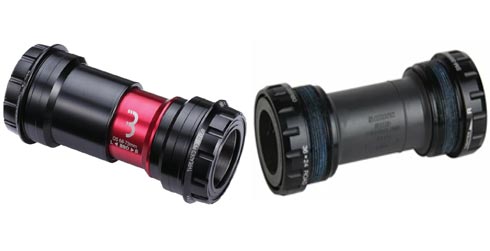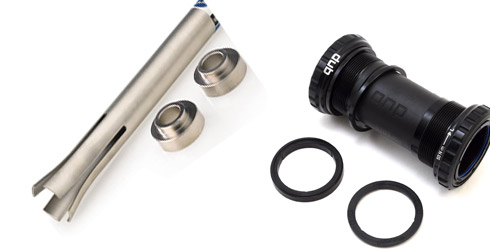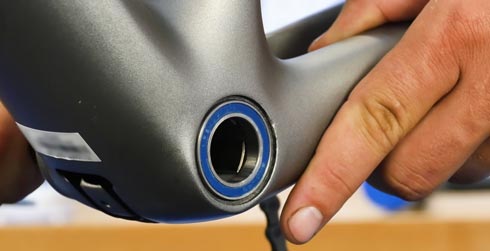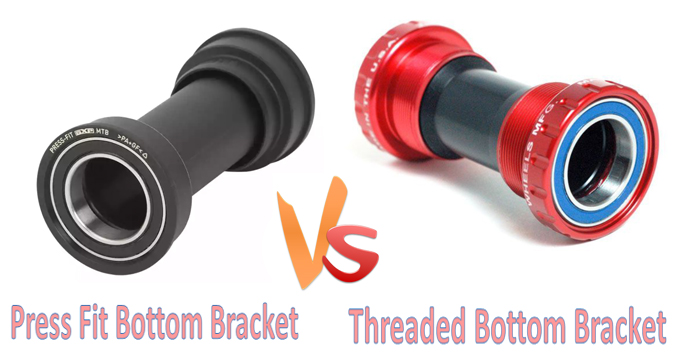Bottom bracket types are divided into two categories: press-fit and threaded. The difference between the two is that a threaded bottom bracket has threads on the inside of the cups, while a press-fit bottom bracket does not.
Press-fit bottom brackets are typically used with frames made by manufacturers who do not want to cut threads in their frame’s aluminum shell for compatibility reasons or because it would make servicing more difficult.
Threaded type is most commonly found on bikes with steel frames where there’s no need to worry about compatibility issues or serviceability considerations. This article will focus on the difference between press fit and threaded bottom bracket.
What is a Press Fit Bottom Bracket?

A press-fit bottom bracket is two aluminum cups pressed together with bearings and the axle/spindle assemblies held in place by an interference fit.
When installing a new press-fit bottom bracket, if the cups are not aligned perfectly on either side of the bike, it will cause creaking or other noises.
If this happens, remove the crankset from the installed bottom bracket and rotate both cups equally until you achieve a perfect alignment.
What Is a Threaded Bottom Bracket?

Conventional threading on the inside of the bottom bracket BB shell allows for easy installation and removal of a compatible crankset. The crank is attached to an axle inserted into one side of the bottom bracket.
On the other side of the bottom bracket is an external bearing, which makes it possible to remove or install your crankset without removing the entire bottom bracket assembly.
What Is the Difference between Press Fit and Threaded Bottom Bracket?

Press fit bottom brackets have bearings pressed directly into the frame shell. A threaded bottom shelf has a thread on the inside of one cup and enduro bearings on the other side.
Below are some of the differences that can be found between a press fit bottom bracket and a threaded bottom bracket:
Easy to Install and Remove
Threaded bottom brackets can be installed and removed easily because the external bearing makes it possible to grab hold of the crank and simply pull out.
On the other hand, press fit bottom brackets cannot be removed unless you first remove the bearing or separate it from the frame, which is no easy task. This makes press fit bottom brackets almost impossible to remove without damaging the bearings and structure itself.
Durability
Press fit bottom brackets seem to have a reputation for being less durable than threaded ones because of how difficult they are to remove and install on your bike.
Threaded bottom brackets seem to last longer than press-fit setups since you can service them without having to break down the entire assembly (pressing cups off bearings).
Frame Compatibility
To install a press-fit bottom bracket, you first need to make sure the frame is compatible because some frames do not have enough material to accommodate a press-fit system.
Threaded bottom brackets can be installed on any frame as long as the threads are properly sized and there’s enough room for bearings.
Serviceability
Threaded bottom brackets can be serviced easily using commonly available tools, making it possible to replace worn-out parts without breaking down the entire assembly.
Press fit bottom brackets cannot be serviced unless you separate them from the frame, a very difficult task that requires a lot of force and might damage the shell of your bike which could lead to expensive repairs or replacement if you’re not careful.
Maintenance
Regular service is critical to the performance and longevity of a threaded bottom bracket since they tend to operate in a dirty environment.
On the other hand, a press-fit bottom bracket requires very little maintenance apart from replacing worn-out parts once in a while, which is usually simple enough as long as you have a compatible press fit bearing set with you.
Compatibility
Press-fit bottom brackets are not compatible with most conventional cranksets since they use external bearings that do not fit inside the shell of your bike.
Threaded bottom brackets can be used with almost any crankset as long as they are made for your crank threading system and match the right bottom bracket type.
Weight
Press-fit bottom brackets generally weigh less than threaded ones because they are typically made using lightweight materials such as plastic or carbon fiber.
Threaded bottom brackets tend to weight more than press-fit systems due to the need for stronger components that can handle high stress and force, especially when pedaling hard.
When to Use a Threaded or Press Fit Bottom Bracket?

Threaded bottom brackets are more common than press fit ones because they are easier to service and adjust. Threaded bottom brackets might seem like a better choice for your bike, especially if you want something that can be easily removed and replaced with minimal fuss.
Press-fit bottom covers on the other hand would be a better option if you own an expensive frame that cannot accommodate threaded cups or is made of carbon fiber which makes it impossible to separate or remove the bearings without damaging the shell.
The good thing about press-fit bottom brackets is that they tend to last longer than threaded counterparts since they do not expose their inner components directly to dirt and dust, but at the same time require special tools in order to be adequately serviced.
If you’re looking for the least expensive bottom brackets that are easy to install and service, then threaded bottom brackets with external bearings might be a better choice for your bike. Press-fit bottom brackets are better suited for more expensive frames or bikes that need special components due to their unusual design.
How to Install a Threaded or Press Fit Bottom Bracket?

The following step-by-step guide shows how to install a press fit bottom bracket:
- Make sure you have an appropriate tool such as a crank puller or special press-fit bottom bracket installation kit since they usually come with the necessary tools and spare parts including bearing spacers, washers, and cups.
- Check the compatibility of your frame to see if it can accommodate a press-fit bottom bracket such as one with a 42mm inner diameter.
- Loosely assemble the press fit bottom bracket in order to keep it from damaging the frame when you insert or remove it through the bottom bracket shell.
- Install and tighten the tool that holds the press fit bearing race in place while installing the spindle and bearings.
- Remove the tool while guiding the press fit bearing race into the bottom bracket shell.
- Remove any dirt or debris that might prevent your bearings from rotating freely inside its housing while you install the spacers and washers, then secure them in place using your external bottom bracket cups.
- Apply adhesive to ensure tightness and to prevent water or dirt from entering the bottom bracket shell.
- Insert your cranks and check if they spin freely without hitting against each other or the frame.
- Tighten your external bottom bracket cups in order to secure them into place when pedals are fully tightened into their axles.
The following step-by-step guide shows how to install a threaded bottom bracket:
- Remove your existing bottom bracket, and then clean the bottom bracket shell in order to remove any dirt or debris that might prevent you from removing your current system.
- Loosely assemble your new threaded bottom brackets inside its housing in order to prevent it from damaging the frame while installing the spindle and bearings.
- Tighten your external bottom bracket cups in order to secure them into place when you rotate your cranks and check if they spin freely without hitting against each other or the frame.
- Apply thread tape or anti-seize lubricant as needed, then tighten down your locking nuts for a tight fit.
- Re-install your cranks, and then tighten them in place for a secure fit.
Pros and Cons of Using a Threaded or Press Fit Bottom Bracket

The following list shows the pros and cons of using a threaded and press-fit bottom bracket:
Pros:
- Standard design allows you to install almost any cranks without much hassle.
- Easier to service since bearings are exposed directly for easy access.
- Lowers production costs due to its standard design.
Cons:
- Inferior quality compared to press fit bottom brackets.
- Weaker spindle design makes it more susceptible to damage.
- Not compatible with some frames or bikes that have unusual designs or oversized bottom bracket shells.
Pros:
- Better resistance against dirt and dust which improves durability.
- Provides a smoother spin since bearings are protected inside a sealed housing.
- Better resistance against corrosion due to its sealed design.
Cons:
- Expensive system since it requires special tools and bearing sizes.
- Not compatible with some frames or bikes that have unusual designs or oversized bottom bracket shells.
Frequently Asked Questions
How Long Does the Process Take?
The average time it takes to install a press fit bottom bracket is around one hour which might vary depending on the process.
What Tools are required?
Most crank pullers and special press-fit bottom bracket installation kits include all the necessary tools needed for this process including bearing spacers, washers, and cups.
Which Is Better, A Threaded or Press Fit Bottom Bracket?
Press fit bottom brackets are better than threaded ones because they offer a tight seal that protects your bearings against dirt and debris.
Why Do I Need To Replace My Old Pedal with a New One?
You might need to replace your pedal with a new one because most pedals are not compatible with threadless bottom brackets which means you’ll need an adjustable spindle in order to install the bottom bracket without damaging it.
Final Thought
Both threaded and press-fit bottom brackets have their advantages, but the best one for you will depend on your needs. If you need to replace pedals with a new pedal compatible with threadless bottom bracket systems, go with a threaded system. However, if protection against dirt or debris is important to you, then consider using a press-fit design instead since it offers better insulation of bearings from potential contaminants in the environment. We hope this has helped!

